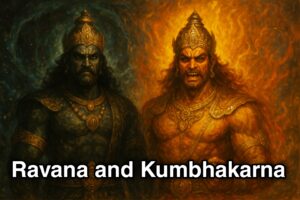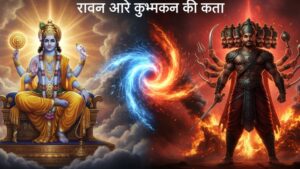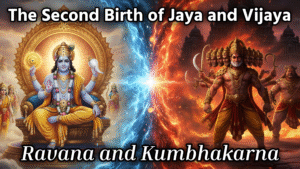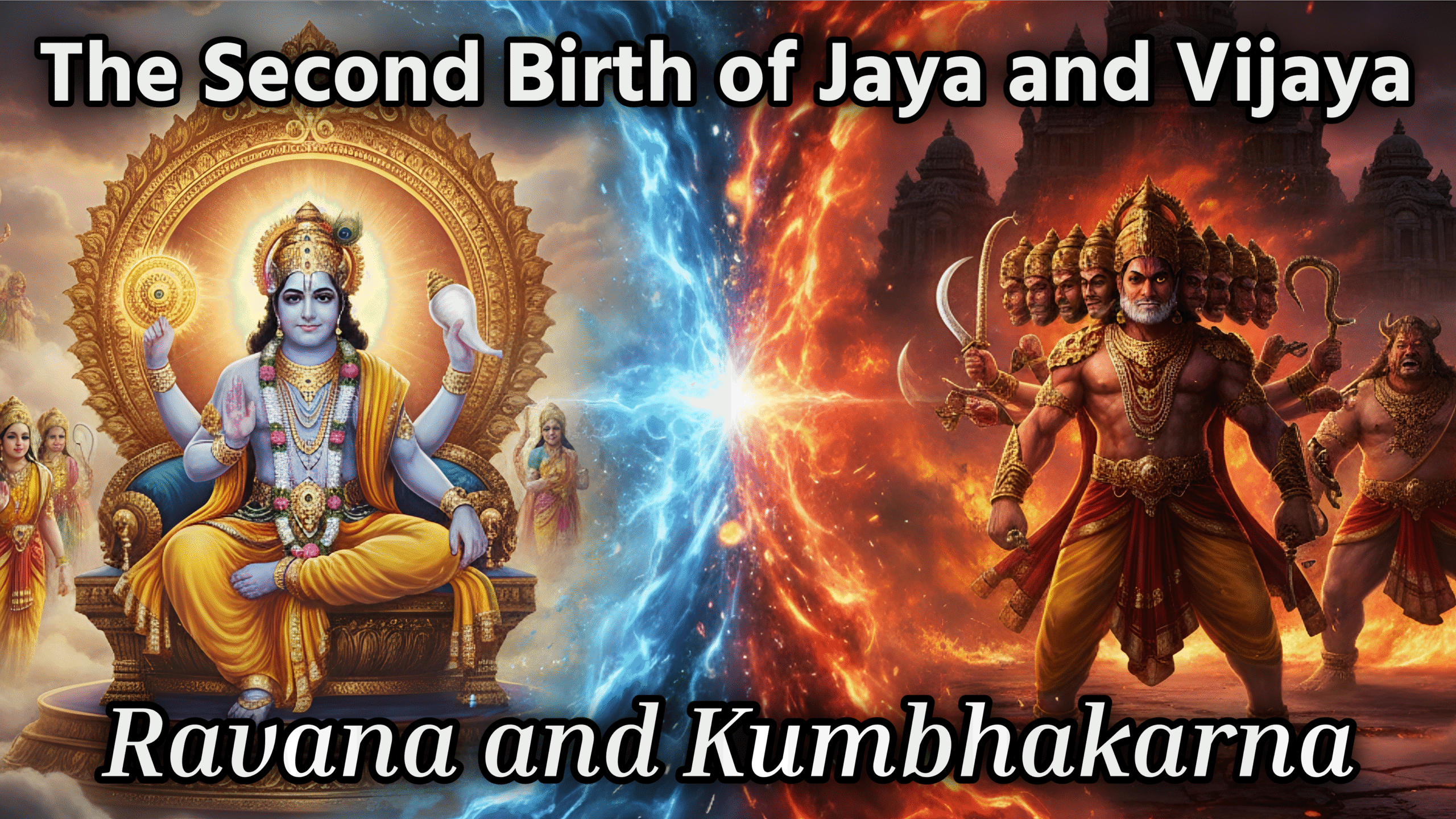
The Second Birth of Jaya and Vijaya: Ravana and Kumbhakarna
In the endless cycle of creation and dissolution, every soul — even the most divine — experiences the law of karma and destiny. Among the most profound stories in Sanatan Dharma is that of Jaya and Vijaya, the revered gatekeepers of Vaikuntha, whose devotion to Lord Vishnu led them through three mortal births — each time as powerful beings opposing the Lord Himself.
Their second incarnation, as Ravana and Kumbhakarna, is one of the most compelling and spiritually symbolic episodes in the Ramayana — a cosmic drama where even opposition to the Divine becomes a path to liberation.
The Origin of the Curse
Once, the four eternal sages — Sanaka, Sanandana, Sanatana, and Sanatkumara — came to Vaikuntha seeking Lord Vishnu’s darshan. Jaya and Vijaya, fulfilling their duty as gatekeepers, stopped them at the entrance, not recognizing their supreme spiritual status.
Feeling disrespected, the sages cursed them to be born in the mortal realm, separated from their beloved Lord.
When Lord Vishnu appeared, He softened the curse and gave them two choices:
To be born as His devotees for seven lifetimes, or
To be born as His enemies for three lifetimes, and return sooner to Vaikuntha.
Eager to reunite with their Lord quickly, Jaya and Vijaya chose to face Him as His opponents for three births.
First Birth: Hiranyaksha and Hiranyakashipu
In Satya Yuga, they appeared as the asuras Hiranyaksha and Hiranyakashipu, who were ultimately liberated by Lord Vishnu in His forms of Varaha and Narasimha.
Their souls then ascended again to wait for their next birth — as destiny continued its divine design.
Table of Contents

Second Birth: Ravana and Kumbhakarna
In Treta Yuga, Jaya and Vijaya took birth as Ravana and Kumbhakarna, the sons of sage Vishrava and demoness Kaikesi.
Ravana, blessed with ten heads symbolizing his mastery over the ten directions of knowledge, was a great devotee of Lord Shiva and a scholar of the Vedas and Upanishads. His power and intellect were unmatched, yet his growing pride and desire for supremacy led him away from dharma.
Kumbhakarna, his mighty brother, was equally wise and devoted. However, due to a twist in divine play, he received a boon that made him sleep for long intervals. Despite this, he remained loyal and stood by Ravana until the very end.
The Role They Played in the Lord’s Leela
When Vishnu descended as Shri Rama, the Maryada Purushottam, destiny set the stage for the grand confrontation.
Ravana’s abduction of Mata Sita was not merely an act of arrogance — it was a part of the divine plan to bring Lord Rama to Lanka and fulfill the purpose of His incarnation: to restore dharma and free Jaya and Vijaya from their earthly bond.
Through the epic battle of Ramayana, both brothers played their destined parts with great courage, loyalty, and strength — showcasing not evil, but the consequences of imbalance between knowledge and ego.
The Vadh (Liberation) of Ravana and Kumbhakarna
When the time came, both brothers met their end not as villains, but as souls returning to their eternal abode.
Kumbhakarna, awakened from his long sleep, understood the divine truth behind the events. Knowing that Lord Rama was none other than Vishnu Himself, he entered the battlefield with full awareness. He fought valiantly, and when struck by Lord Rama’s divine arrow, he accepted his fall with folded hands — his soul instantly attaining liberation.
Ravana, too, despite his arrogance, was not devoid of wisdom. In his final moments, when he faced Lord Rama, he realized the truth of his own divine connection. As Lord Rama released the sacred Brahmastra, Ravana accepted it calmly, knowing it was the end of his mortal role and the beginning of his return to Vaikuntha.
Thus, their vadh was not punishment — it was moksha. Through the Lord’s grace, both Jaya and Vijaya were freed from their curse and reunited once more with Lord Vishnu in the eternal realm.
The Spiritual Message
The story of Jaya and Vijaya’s second birth holds deep lessons for every seeker:
Pride can overshadow wisdom, no matter how great one’s knowledge or devotion.
Even divine opposition serves a higher purpose, for the Lord’s plan is beyond human understanding.
True liberation lies in surrender, recognizing the Lord’s will behind every joy and sorrow.
Their story teaches that in Sanatan Dharma, even those who stand against the Divine are never outside His grace. Every soul — through devotion, realization, or destiny — ultimately finds its way back to the source.

Conclusion
The tale of Ravana and Kumbhakarna is not a story of defeat, but of divine reunion.
It reminds us that the leela of the Lord is beyond good and evil — it is the eternal process of balance, learning, and liberation.
Through their vadh, Jaya and Vijaya fulfilled their promise and returned to their true forms, once again standing guard at the gates of Vaikuntha — this time, with deeper humility and devotion.
🔱 “Even those who oppose the Divine serve His will, for in the end, all paths lead back to Him.” 🔱
❓ Frequently Asked Questions (FAQs)
- Who were Jaya and Vijaya?
Jaya and Vijaya were the divine gatekeepers of Vaikuntha, the abode of Lord Vishnu. They were loyal devotees who guarded the entrance to the Lord’s eternal realm.
- Why were Jaya and Vijaya cursed?
They were cursed by the four Kumaras — Sanaka, Sanandana, Sanatana, and Sanatkumara — for stopping them from meeting Lord Vishnu. The sages, feeling disrespected, cursed them to take birth on Earth.
- What choice did Jaya and Vijaya make after being cursed?
Lord Vishnu gave them two options: to be born as His devotees for seven lifetimes, or as His enemies for three. They chose the second, wishing to return to Vaikuntha sooner.
- In which yugas did they take their three births?
Satya Yuga: Hiranyaksha and Hiranyakashipu (slain by Varaha and Narasimha)
Treta Yuga: Ravana and Kumbhakarna (liberated by Lord Rama)
Dvapara Yuga: Shishupala and Dantavakra (slain by Lord Krishna)
- Who were Ravana and Kumbhakarna’s parents?
They were born to Sage Vishrava (a Brahmin sage) and Kaikesi (daughter of demon king Sumali), thus having both divine wisdom and demonic lineage.
- Was Ravana truly evil?
Ravana was not purely evil. He was a great scholar, a devotee of Lord Shiva, and a master of the Vedas. However, his arrogance and desire for supremacy led him away from dharma, causing his downfall.
- Did Kumbhakarna know who Lord Rama really was?
Yes. Before entering the battlefield, Kumbhakarna realized that Lord Rama was none other than Lord Vishnu. He fought not out of ignorance, but out of duty to his brother and to fulfill divine destiny.
- How did Ravana and Kumbhakarna attain liberation?
When Lord Rama defeated them, both accepted their fate with awareness of the divine truth. Their vadh was a sacred act of liberation, allowing their souls to return to Vaikuntha as Jaya and Vijaya.
- What spiritual message does their story convey?
It teaches that even opposition to God can lead to liberation, as everything in creation serves the Lord’s will. Pride leads to downfall, but realization and surrender bring redemption.
- What happened after their second birth?
After being liberated by Lord Rama, they were again born in Dvapara Yuga as Shishupala and Dantavakra, and finally returned to Vaikuntha after being slain by Lord Krishna.
🕉️ Summary: The Second Birth of Jaya and Vijaya as Ravana and Kumbhakarna
The story of Jaya and Vijaya’s second birth as Ravana and Kumbhakarna in Treta Yuga reveals the deeper mysteries of Sanatan Dharma. Once the gatekeepers of Vaikuntha, they were cursed by the four Kumaras to be born on Earth. Choosing to face the Lord as His enemies for three lifetimes, they appeared as the mighty demon brothers — Ravana, the ruler of Lanka, and Kumbhakarna, his loyal companion.
Their confrontation with Lord Rama was not merely a battle of good versus evil but a divine play (leela) to fulfill cosmic balance. Their eventual vadh (end) at the hands of Lord Rama symbolized not defeat, but liberation (moksha) — the completion of their karmic cycle and return to their eternal post in Vaikuntha.
This tale teaches profound lessons on ego, devotion, destiny, and divine grace — showing that every being, no matter their role, ultimately journeys back to the Supreme.
Unlock the Ancient Wisdom of Sanatan Dharma – Join Us on YouTube!
👉 Subscribe now to Prachin Sanatan Dharma and embark on a journey of enlightenment.
Explore timeless teachings, spiritual insights, and cultural richness on our YouTube channel, Prachin Sanatan Dharma. Dive deep into the essence of Sanatan Dharma through captivating videos that inspire and educate.
Related Articles
- Restful Nights: Ayurvedic Remedies and Traditional Indian Practices to Overcome Insomnia and Late-Night Habits
- The Tridevi: Lakshmi, Saraswati, and Parvati – Their Roles and Powers
- “Divine Creatures of Ancient Indian Scriptures: Exploring the Role of Animals in the Vedas, Puranas, and Mahabharata”
- Nature and Spirituality: Exploring the Sacred Essence of the Himalayas, Ganga, and Other Natural Wonders”
- “Reviving the Gurukul System: Relevance and Lessons for Modern Education”
- “Exploring Greek and Indian Mythology: Similarities Between Greek and Indian Mythology “
- “Embracing Sattvic Living: Harmonizing Mind, Body, and Soul Through Food and Lifestyle”
- “Charity and Prosperity: Exploring the Concept of Daan and Its Financial Relevance in Modern Life”
- How to Build an Eco-Friendly Home Inspired by Vastu Shastra
- Comparison of Ancient and Modern Sports: How Traditional Sports Have Influenced Contemporary Games
- “Timeless Lessons from Ancient Tales: Linking Samudra Manthan and Ganga’s Descent to Modern Ecological Challenges”
- “Reviving Sanskrit: How AI is Preserving Ancient Languages for the Future”
- “Mathura: The Sacred Land of Lord Krishna’s Divine Leelas”
- Investing for Future Generations: Lessons from Indian Traditions on Legacy Building and Wealth Preservation
- “Ancient Indian Wisdom: Timeless Lessons for Tackling Today’s Climate Crisis”
- “Artificial Intelligence and Spirituality: Transforming Ancient Practices for the Modern World”
- “Gold and Real Estate in India: Timeless Assets Shaping Financial Strategies”
- Tradition Meets Innovation: The Evolution of Technology in Hindu Rituals
- End-of-World Myths: Exploring Kali Yuga in Hinduism and Ragnarök in Norse Mythology
- Garuda, Pegasus, and Dragons: The Universal Ties of Mythical Beasts Across Cultures
- “Ancient Vimanas: Mythical Flying Machines or Evidence of Advanced Technology?”
- Time Travel in Hindu Mythology: The Fascinating Tales of Kakudmi and King Raivata
- “Divine Feminine Power in Hindu Mythology: The Legends of Durga, Saraswati, and Lakshmi”
- “Divine Beings of Sanatan Dharma: The Spiritual Significance of Sacred Animals in Hinduism”
- “Symbolism in Mythological Art: Unlocking Hidden Meanings in Ancient Temple Carvings”
- “Exploring Technological Advancements in Ancient India and Civilizations: Vimana, Metallurgy, & Water Management systems”
- Unveiling the Mysteries: Ancient Temples of Sanatan Dharma , Mysterious Temples of India
- “The Scientific Knowledge of Sanatan Dharma: Ancient Wisdom Meets Modern Science”
- Ancient Indian Sports and Games: Celebrating a Legacy of Skill, Strength & Strategy”
- “Exploring the Cosmic Link: The Connection Between Astronomy and Vedic Astrology”
- The Power of Sanskrit: Unlocking the Divine Language of the Gods
- “The End of Kaliyuga: A Sanatan Insight into the World’s Final Chapter”
- Explore more articles on Prachin Sanatan Yuga.
The Second Birth of Jaya and Vijaya: Ravana and Kumbhakarna The Second Birth of Jaya and Vijaya: Ravana and Kumbhakarna The Second Birth of Jaya and Vijaya: Ravana and Kumbhakarna The Second Birth of Jaya and Vijaya: Ravana and Kumbhakarna The Second Birth of Jaya and Vijaya: Ravana and Kumbhakarna The Second Birth of Jaya and Vijaya: Ravana and Kumbhakarna
The Second Birth of Jaya and Vijaya: Ravana and Kumbhakarna The Second Birth of Jaya and Vijaya: Ravana and Kumbhakarna The Second Birth of Jaya and Vijaya: Ravana and Kumbhakarna The Second Birth of Jaya and Vijaya: Ravana and Kumbhakarna The Second Birth of Jaya and Vijaya: Ravana and Kumbhakarna The Second Birth of Jaya and Vijaya: Ravana and Kumbhakarna
The Second Birth of Jaya and Vijaya: Ravana and Kumbhakarna The Second Birth of Jaya and Vijaya: Ravana and Kumbhakarna The Second Birth of Jaya and Vijaya: Ravana and Kumbhakarna The Second Birth of Jaya and Vijaya: Ravana and Kumbhakarna The Second Birth of Jaya and Vijaya: Ravana and Kumbhakarna The Second Birth of Jaya and Vijaya: Ravana and Kumbhakarna
